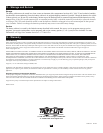
[5]
3 – Battery Cabinet Installation
Read Section 2 – Important Safety Instructions Before Installation
3-1 Preparation
• At your site, prepare to off-load the battery cabinet from the delivery truck and transport it to the final installation location.
Consider both the packaged weight and dimensions.
• Assure that the floor can bear the load of the specific battery cabinet being installed. The battery cabinet must be installed in a
structurally sound area with a level floor that is able to bear the weight of the battery cabinet and other equipment that will be
installed nearby.
• Draw a wiring schematic representing the cables connected between the battery cabinet’s output terminal blocks and any
external disconnect device, junction box and/or load/rectifier.
• If you plan to store the battery cabinet for an extended period before or after installation, follow the instructions in Section 8
– Storage and Service.
3-2 Transportation
1. Inspect the shipping container(s) for visible damage. (Do not remove the stretch wrap around the unit until it has been
transported to the final installation location.) Confirm that the model name and rating match the unit you ordered. If you
determine that the unit has been damaged during shipping, or if anything appears to be missing, contact Tripp Lite for
assistance. Do not attempt to use the unit if it has been damaged or mishandled.
2. Do not attempt to move or unpack the battery cabinet without assistance. Use appropriate handling equipment rated to bear
the weight and bulk of the battery cabinet, such as freight elevators, pallet jacks and forklifts. (Fully extend forks under load.
Spread forks to maximum possible width under load. Lift cabinet from bottom only. Wear safety shoes.) Confirm that load
limits for freight elevators, handling equipment and floors along the transport route will not be exceeded by the combined
weight of the packaged battery cabinet, handling equipment and personnel. Confirm that the packaged unit will pass through
any doorways along the intended route.
3. The battery cabinet is secured with stretch wrap to protect it during shipping and movement within a facility. Remove the
stretch wrap from the battery cabinet when the unit is in the final installation location—not before.
3-3 Mechanical Check
While the assembled cabinet battery system is still on the shipping pallet, inspect all sides for impact or other damage.
1. Remove front access panels and set them aside, being careful not to scratch the finish.
2. Confirm that all individual batteries are secure in the battery cabinet and that no batteries have been damaged.
3. Confirm that none of the internal parts (terminal blocks, fuse blocks, fuses, circuit breakers and other parts) have been
damaged.
4. If the battery cabinet includes an integrated battery charger (“C” models only), examine the wires at the DC output terminal
closely. If any of the leads are bent or otherwise damaged from shipping, contact Tripp Lite. Damaged leads could cause a
battery short circuit.
5. Note the individual battery model number and refer to Section 7-2 for the battery’s terminal type and recommended torque.
6. Use insulated tools to tighten all the battery terminal connections to the recommended torque.
7. Use insulated tools to tighten the cables from the positive and negative output terminals at the end batteries to the output
terminal block, fuse block or circuit breaker.


















